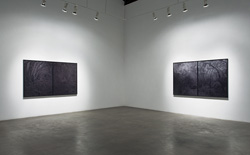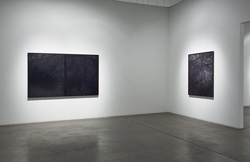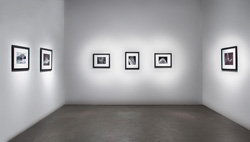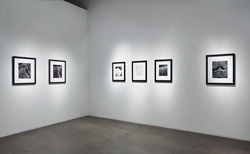December 4, 2010 - January 8, 2011
Reception: December 4, 2010 4-6PM
Brian Forrest’s photographs are made in the Santa Monica Mountains, an often-overlooked natural environment within L.A.’s urban sprawl. Working with a large format camera, his images of dense brush and tangled branches are captured at the very low light of dusk. As the artist notes, in this diminishing light, color sensitivity fades and the world moves closer to black and white, thus exposing rather than concealing new shapes and spaces in the natural landscape. His large-scale (50x80”) photographs may appear completely black at first glance, but like the environment he seeks to convey, they gradually reveal details. As Christopher Knight suggests, “Spend a moment, and out of the inky darkness landscape imagery slowly comes into view.” Knight also discovered his own shadow on the dark surface of the artworks and observed that the viewer “becomes a shadow-figure…appearing to move through the underbrush. Like light and space [artworks], Forrest’s photographs engage perceptual phenomena to revelatory effect.”
Concurrently, the gallery will present an exhibition of black and white photographs by Rose-Lynn Fisher entitled Bee. Working with a scanning electron microscope, Fisher records in extraordinary detail, the intricate and complex anatomy of bees. She notes that, “this project really began the first time I saw the bee’s eye and was amazed to see that it echoed the structure of the honeycomb.” Her recognition of fundamental patterns in nature, from the molecular to the universal, echoes John Steinbeck’s observation that “it is advisable to look from the tide pool to the stars and then back to the tide pool again.” Reflecting on the bee, Fisher takes her observation even further and wonders if the corresponding hexagonal structures could hint at "a parallel kind of encoding relevant to humanity, like fractals or the golden mean, symbolically describing the correspondence between a deeper capacity to see and to do." Crisp in detail and high in contrast, the images sometimes look like scratchboard drawings of surreal landscapes or extraterrestrials, but closer study reveals what Fisher calls a “congruency of form and function, vision and action, spirit and matter.” She concludes that the recent plight of bees has demanded a closer look at their needs and our responsibility for protecting their existence.
The infinite complexities revealed in the subtle landscapes of Brian Forrest and the microscopic details of Fisher’s bees are the rewards that Rainer Maria Rilke promised, “if you will cling to Nature, to the simple in Nature, to the little things that hardly anyone sees, and that can so unexpectedly become big and beyond measuring.”
A reception for the artists will be held at Craig Krull Gallery on Saturday, December 4, 4-6pm. Rose-Lynn Fisher will be signing copies of her new book Bee, published by Princeton Architectural Press.





